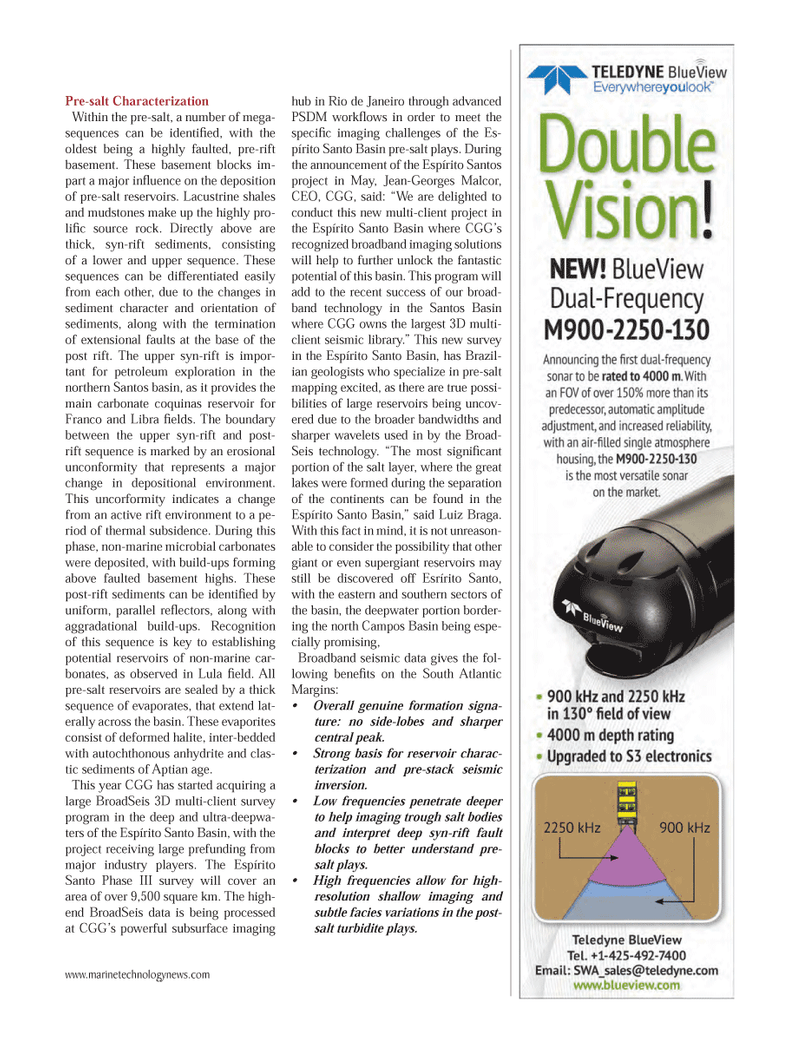
Page 37: of Marine Technology Magazine (October 2014)
Subsea Defense
Read this page in Pdf, Flash or Html5 edition of October 2014 Marine Technology Magazine
Pre-salt Characterization Within the pre-salt, a number of mega- sequences can be identiÞ ed, with the oldest being a highly faulted, pre-rift basement. These basement blocks im- part a major inß uence on the deposition of pre-salt reservoirs. Lacustrine shales and mudstones make up the highly pro- liÞ c source rock. Directly above are thick, syn-rift sediments, consisting of a lower and upper sequence. These sequences can be differentiated easily from each other, due to the changes in sediment character and orientation of sediments, along with the termination of extensional faults at the base of the post rift. The upper syn-rift is impor- tant for petroleum exploration in the northern Santos basin, as it provides the main carbonate coquinas reservoir for Franco and Libra Þ elds. The boundary between the upper syn-rift and post-rift sequence is marked by an erosional unconformity that represents a major change in depositional environment. This uncorformity indicates a change from an active rift environment to a pe- riod of thermal subsidence. During this phase, non-marine microbial carbonates were deposited, with build-ups forming above faulted basement highs. These post-rift sediments can be identiÞ ed by uniform, parallel reß ectors, along with aggradational build-ups. Recognition of this sequence is key to establishing potential reservoirs of non-marine car- bonates, as observed in Lula Þ eld. All pre-salt reservoirs are sealed by a thick sequence of evaporates, that extend lat- erally across the basin. These evaporites consist of deformed halite, inter-bedded with autochthonous anhydrite and clas-tic sediments of Aptian age. This year CGG has started acquiring a large BroadSeis 3D multi-client survey program in the deep and ultra-deepwa- ters of the Esp?rito Santo Basin, with the project receiving large prefunding from major industry players. The Esp?rito Santo Phase III survey will cover an area of over 9,500 square km. The high- end BroadSeis data is being processed at CGGÕs powerful subsurface imaging hub in Rio de Janeiro through advanced PSDM workß ows in order to meet the speciÞ c imaging challenges of the Es- p?rito Santo Basin pre-salt plays. During the announcement of the Esp?rito Santos project in May, Jean-Georges Malcor, CEO, CGG, said: ÒWe are delighted to conduct this new multi-client project in the Esp?rito Santo Basin where CGGÕs recognized broadband imaging solutions will help to further unlock the fantastic potential of this basin. This program will add to the recent success of our broad-band technology in the Santos Basin where CGG owns the largest 3D multi- client seismic library.Ó This new survey in the Esp?rito Santo Basin, has Brazil-ian geologists who specialize in pre-salt mapping excited, as there are true possi- bilities of large reservoirs being uncov- ered due to the broader bandwidths and sharper wavelets used in by the Broad- Seis technology. ÒThe most signiÞ cant portion of the salt layer, where the great lakes were formed during the separation of the continents can be found in the Esp?rito Santo Basin,Ó said Luiz Braga. With this fact in mind, it is not unreason- able to consider the possibility that other giant or even supergiant reservoirs may still be discovered off Esr?rito Santo, with the eastern and southern sectors of the basin, the deepwater portion border- ing the north Campos Basin being espe-cially promising,Broadband seismic data gives the fol- lowing beneÞ ts on the South Atlantic Margins: Overall genuine formation signa- ture: no side-lobes and sharper central peak. Strong basis for reservoir charac- terization and pre-stack seismic inversion. Low frequencies penetrate deeper to help imaging trough salt bodies and interpret deep syn-rift fault blocks to better understand pre- salt plays. High frequencies allow for high- resolution shallow imaging and subtle facies variations in the post-salt turbidite plays.www.marinetechnologynews.com MTR #8 (34-49).indd 37MTR #8 (34-49).indd 3710/13/2014 2:12:53 PM10/13/2014 2:12:53 PM

 36
36

 38
38
